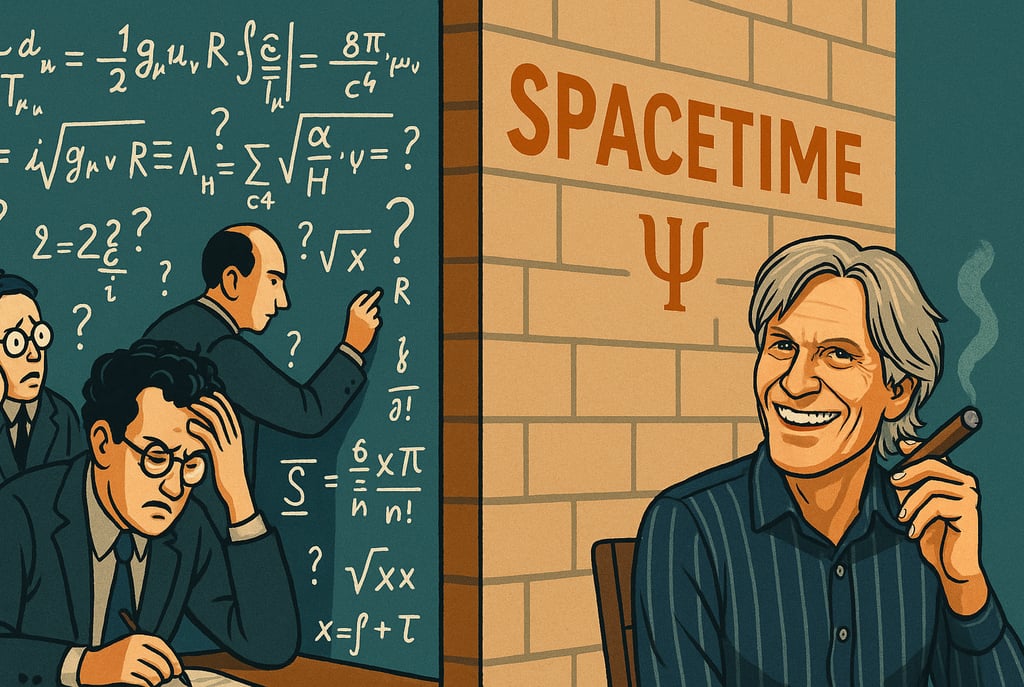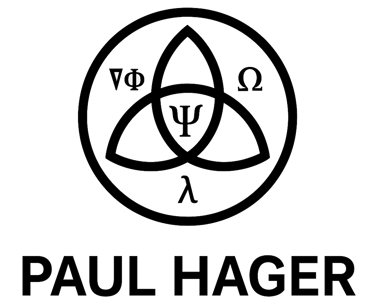What Physics Misses When It Starts with Space
Modern physics explains almost everything — except itself. Why do we need hundreds of separate laws to describe one universe? This article explores a radical alternative: space and time aren't the backdrop, but the result. Based on a new quantum-tensional field model, it proposes that all forces, particles and even consciousness emerge from one coherent field. Simple, testable, and revolutionary.
POPULAR
Paul Hager
6/2/20256 min read


Modern physics is brilliant. It can predict Mercury's orbit to a fraction of an arcsecond, simulate the inside of a black hole, estimate the age of the universe, and explain why water boils at 100 degrees Celsius. No other science is so precise, so disciplined, so successful.
And yet something feels off. Despite all these triumphs, physics looks more like a patchwork than a unified theory: a mix of separate models, each with its own laws, constants, and assumptions.
We use Einstein for gravity. Maxwell for electromagnetism. Schrödinger and Dirac for atoms. Boltzmann and Gibbs for temperature. The Standard Model for particles. FLRW equations for the universe. Lorenz for chaos. Wave-particle duality for light. Quarks and leptons for matter. Nothing clear for time. Nothing at all for consciousness.
And that’s just the beginning. In truth, physics relies on hundreds of isolated laws, parameters, and equations—each limited to its own domain, each with its own mathematical dialect. The Standard Model alone has dozens of adjustable constants. Fluid dynamics, quantum optics, and thermodynamics all require distinct frameworks.
This fragmentation isn't just theoretical. It’s institutional. Universities split physics into narrow disciplines: astrophysics, quantum field theory, biophysics, materials science, statistical mechanics. Each has its own departments, journals, and conferences. Students are tracked into specializations early and rarely cross into other domains. A quantum chromodynamics expert will almost never engage with a nonlinear thermodynamics researcher—let alone use the same math.
The result: it’s as if every physical phenomenon needs its own private universe of laws. Not because nature is that complicated, but because our starting assumption forces us into it. We try to describe everything within a backdrop we never question.
Spacetime as an Invisible Assumption
Since Newton, physics has assumed that anything that exists must be somewhere and happen sometime. Space and time are the canvas. We draw things—masses, fields, particles—onto it and describe their behavior.
Einstein reshaped that canvas by allowing space to curve. But even he didn’t question the basic assumption: things still exist within spacetime.
And that’s the problem.
Because when you treat spacetime as given, you have to project every phenomenon onto it. Each effect then demands its own description within the background. You’ll never find a unifying explanation, because you already locked in the frame.
It’s like trying to understand ocean waves without ever studying water. You measure the height, speed, and curvature of each wave—but never ask what waves are made of.
What If the Background Isn’t Fundamental?
Imagine removing the whole canvas. No space. No time. No energy as a starting point. Just a field. A field that doesn’t describe things, but generates them. A field with no dimensions, no direction, no past or future—until those properties emerge from within.
Such a field exists. Not as a fantasy, but as a rigorously defined structure in quantum mathematics. It’s called Ψ (psi), a field that lives in Hilbert space: an abstract landscape where every possible field state has its own direction and amplitude.
This field Ψ isn’t a field in space. It is not yet space. It’s a field of potential coherence: relationships between tensions, directions, and internal states. When this field internally aligns—when it reaches coherence—something remarkable happens: direction appears. Distance emerges. Time unfolds. Gravity manifests.
Coherence, Direction, Tension
The key parameters are:
Coherence (λ): a measure of internal alignment. When λ is close to 1, the field tends toward dynamic balance. But simulations show that λ can go well above or below 1 depending on tension, noise, or interaction. What matters is the trend: the field can reorganize itself spontaneously toward coherence. That’s critical for stability and spacetime formation.
Direction (∇Φ ≠ 0): the field Ψ holds a gradient—an internal tension indicating which way it "wants" to evolve.
Tension (∇Φ ⊗ ∇Φ): a formal expression of that direction’s strength and shape.
When these come together, something stunning happens. Projecting these tension fields back onto the field itself yields a structure that behaves exactly like spacetime. Distance, time flow, curvature—they all emerge from the field, not the other way around.
In formal terms: spacetime arises as an expectation value of the field's internal tension gradients.
No More Objects in Space—Space from Relation
This flips classical logic on its head. There are no things in space. There is only a field. Where relationships in that field stabilize, structure appears. Where structure organizes, we experience space, time, and force.
In a sense, this echoes what quantum theorists have long suspected: matter is not substance, but pattern. But this model goes further. It claims that even spacetime and gravity are field projections. They exist only when the field allows coherence.
It’s like seeing a landscape emerge the longer you focus—but the landscape is your own coherent gaze. Without alignment, there is no reality.
And Einstein?
Does this contradict Einstein? Not at all. In more than 95% of cases, this model yields the same spacetime structure he predicted: familiar curvature, planetary orbits, gravitational waves. But it explains where that spacetime comes from. Einstein didn’t do that.
Einstein's theory operates inside a given spacetime. This model shows how spacetime arises from tension in a deeper field.
How Do We Know?
Because it’s not just theory. The model is mathematically complete and has been tested numerically. Initial simulations ran on a 32³ grid, then on 64³, with consistent results: the field alone projects measurable spacetime, without preset geometry. A new series using 256³ grids on supercomputers is confirming this with greater precision and dynamical range.
In those simulations, the field Ψ alone produces:
Expected curvature around black holes
An expanding universe, like cosmological models
Small deviations from Einstein's predictions—potentially detectable by instruments like Gaia or LISA
Example: the model predicted Mercury’s orbit precesses 0.020 ± 0.002 arcseconds more per century than Einstein’s theory. It also forecasts minute distortions in gravitational wave propagation—about 0.001 radians—measurable with advanced detectors, pending further refinement.
But one result may be even more profound. In one simulation, the field started completely chaotic: no structure, no direction. Then, without external input, it self-organized. It found coherence. It found direction.
That’s not a technical side-effect. That’s the heart of consciousness: the capacity to create order from within. Perhaps this field isn’t just a model for consciousness. Perhaps it is consciousness, in physical form.
So What?
If this model is right—and all evidence points that way—our understanding of reality changes completely. We no longer need hundreds of disconnected laws to explain nature. We don’t need to merge gravity with quantum mechanics. They are both expressions of the same field.
This would mean that space, time, matter, even awareness—are all projections of field coherence. That there is, at root, only one law: the law of the field, and how it develops tension, direction, and structure.
And that opens an entirely new horizon of applications:
Energy: tension gradients can be projected and reversed. Energy from internal field structure, without raw materials.
Matter: not built, but stabilized projection. Matter can be created without prior mass or energy.
Medicine: if disease is field disruption, healing is restoring coherence. Not treating symptoms, but realigning direction.
Technology: devices that don’t react, but resonate. Not computational, but coherent.
Spirituality: no mysticism, no belief. A physical field that self-recognizes, finds direction, and projects form. Spirituality as precise field dynamics.
Why It Gets Simpler
Remove the canvas, and the picture simplifies. There is only one field. Not abstract, but structurally defined:
∇Φ as direction
λ as coherence
Ω as circulation
gμν as projection to spacetime
This gives:
No 17 particles, but field knots—stable patterns, not building blocks
No 4 forces, but gradations of tension in a single geometry
No inflation hypothesis, but natural relaxation of tension after decoherence
No dark matter, but disturbed field coherence in projection
No arrow-of-time problem, but time as coherence loss: λ decrease driving direction
The laws don’t disappear. They turn out to be local projections of one field. What looked fragmented aligns. What seemed complex becomes derivative of tension, direction, and resonance.
One Field for Everything
Physics’ fragmentation isn’t a mistake, but a stage. It reflects a deeper confusion: imagining reality as things in a stage, instead of a living field. And we—our bodies, thoughts, stars, and theories—are nothing but coherent patterns in it.
The real question isn’t: which law explains what?
It’s: which field gives rise to the laws?
The answer might be:
gμν = ⟨Ψ|∇μΦ ∇νΦ|Ψ⟩
No extra dimensions. No multiverses. No divine singularities. Just a field that understands itself—and becomes everything.
Based on the preprint:
Paul Hager, “Emergent Spacetime from Field Coherence: Quantum-Tensional Geometry in the Ψ-metric Framework without Background Dynamics”
https://doi.org/10.5281/zenodo.15526936
